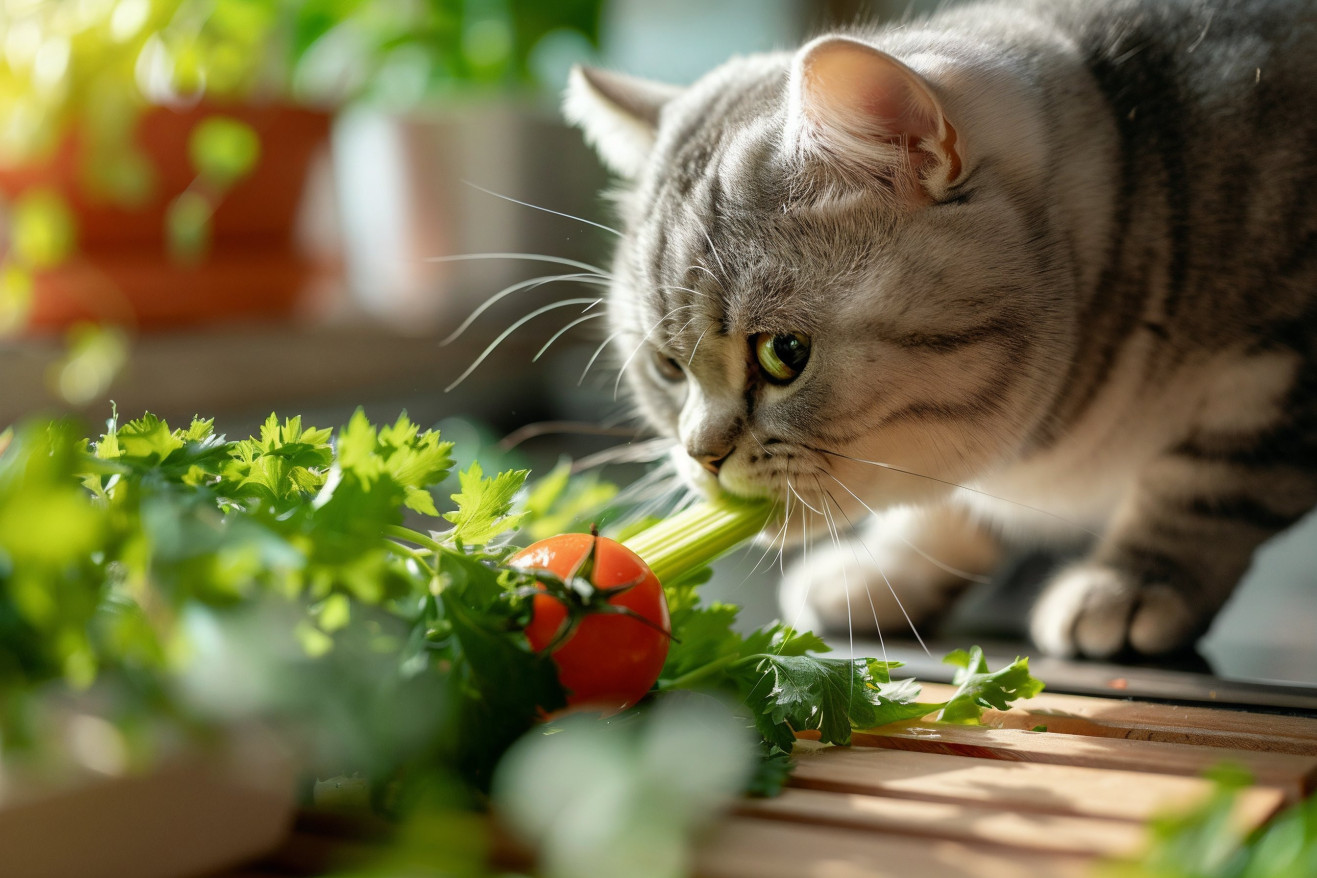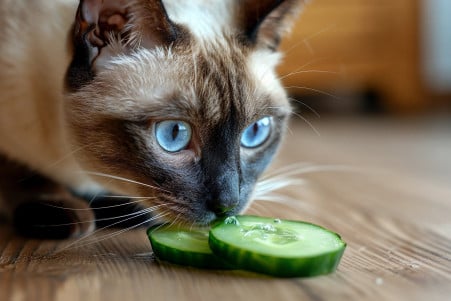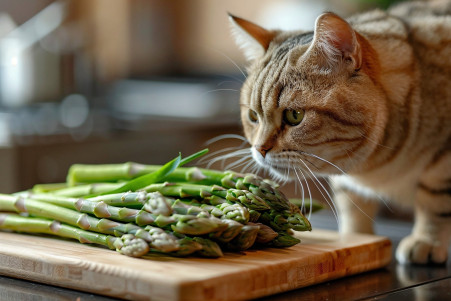Can Cats Eat Celery? Exploring the Safety and Benefits
15 February 2024 • Updated 14 February 2024

Despite being known for their meat-eating ways, is celery a good option for cats? It turns out that cats can eat celery as long as it’s in moderation. The vegetable has vitamins and fiber that can help with digestion and kidney health. Always be sure to wash and cut the celery into small pieces to avoid choking. Make sure to talk to your vet before you start feeding your cat celery.
We’ve pulled from a variety of sources, including veterinary science, studies on feline nutrition, and recommendations for pet diets to give you a well-rounded view of where celery fits in a cat’s diet.
This article will cover how cats’ bodies interact with plant-based foods like celery, the potential effects on their health, and where celery fits in with their natural dietary requirements. With this information, you’ll be able to make informed choices about the treats you give your cat.
Can cats eat celery?
Understanding Why Cats Eat Meat
Cats are obligate carnivores, which means they need to eat a diet that is primarily made up of meat to get the nutrients they need. In other words, cats require nutrients that are only found in animal tissue, including essential amino acids, vitamins, and minerals that their bodies can’t produce on their own.
A study from the School of Veterinary Medicine, UC Davis explains that the natural diet of wild cats is high in protein and moisture and low in carbohydrates, and this is the diet that domestic cats would naturally choose, as holistic veterinarian Dr. Karen Becker points out.
While vegetables aren’t a big part of a diet that’s rich in protein, they can still have a place in it.
For example, vegetables like celery can be added in small amounts to provide extra hydration and nutrients that aren’t found in meat.
That said, the amount of vegetables in a cat’s diet should be in line with their nutritional requirements and natural diet.
While cats aren’t naturally drawn to plant-based foods like celery, some cats may be curious about them or even develop a taste for them.
A meta-study in the British Journal of Nutrition notes that free-roaming feral cats eat very little plant material, and what they do eat is usually accidental.
That said, it’s important to be careful about adding vegetables like celery to a cat’s diet to make sure that it’s still primarily meat-based and meets their nutritional needs.
Nutritional Benefits of Celery for Cats
In addition to being a tasty treat for humans, celery has a number of health benefits for cats. It is a rich source of vitamins, including vitamin K, which is important for bone and blood health. Celery is also high in fiber, which can help improve a cat’s digestion, preventing constipation and supporting a healthy weight, according to CatTime.
In addition, the high water content of celery can help with hydration, which is important for cats, especially those that don’t drink enough water. According to Cat Expedition, celery’s diuretic effects can also help support kidney health by promoting the excretion of toxins and supporting urinary health.
While celery is safe for cats to eat in moderation and when properly prepared—washed to remove any chemicals and cut into small pieces to prevent choking—offering your cat celery can be a healthy and hydrating addition to their diet, ensuring they get the vitamins and minerals they need in addition to their meat-based meals.
How to Safely Feed Celery to Cats
When feeding your cat celery, or any other new food, it’s important to take certain precautions to avoid potential health risks. First and foremost, it’s important to remember that moderation is key. Overeating celery can lead to gastrointestinal issues, including diarrhea and an upset stomach. Therefore, as recommended by CatTime, make sure to only give your cat small amounts of celery, especially when you first start feeding it to them.
Another risk of feeding your cat celery is that it can be a choking hazard if it’s not cut into small enough pieces. To prevent choking, make sure to cut the celery into small pieces that your cat can easily chew and swallow. This will also make it easier for your cat to digest the celery.
Another potential risk of feeding your cat celery is that it can cause an upset stomach if it’s introduced too quickly. To avoid this, make sure to introduce celery to your cat’s diet slowly and keep an eye on how your cat reacts to it.
As VCA Animal Hospitals explains, cats are obligate carnivores, which means that they have sensitive digestive systems that can be easily upset by sudden changes in their diet.
Before feeding your cat celery, or any other new food, it’s important to talk to your vet. Not only can your vet give you personalized advice based on your cat’s specific health needs, but they can also ensure that the new food you want to introduce into your cat’s diet will be safe for them.
This way, you can ensure that you’re making a healthy transition to feeding your cat celery as an occasional treat.
How Celery Fits into a Cat’s Balanced Diet
Treats and occasional snacks, like celery, can be a way to mix things up and even offer some additional nutrients to a cat’s diet. That said, they should be just that: occasional.
The Cornell University College of Veterinary Medicine says that treats, including vegetables, should make up no more than 10 to 15 percent of a cat’s daily caloric intake. A well-balanced diet should be made up primarily of high-quality cat food that meets the complete nutritional standards set by the Association of American Feed Control Officials.
That said, we understand that cats are individuals, and some may even enjoy a snack of celery. If that’s the case, it’s important to make sure that the snack is still a supplement to their regular diet and not a replacement for the nutrients they need from animal sources.
In this way, celery can be a way to add some variety to a cat’s diet while still making sure they get what they need from their food.
This is important because cats are obligate carnivores, which means they need a diet that’s high in animal protein to be healthy, according to the American Animal Hospital Association. So, when you give your cat celery or any other treat, make sure you’re doing it in a way that’s mindful of their overall diet and make sure it’s in moderation.
How Cats Digest Plant Proteins
Studies have shown that the cat digestive system, while optimized for animal proteins, can also digest plant proteins. One study published in PMC found that cats are actually better at digesting proteins than dogs when their diet contains a higher percentage of plant proteins, like those found in celery.
However, the study also found that the digestibility of plant proteins varies. For example, corn gluten meal, a plant protein, is almost as digestible as animal proteins.
When plant proteins like celery are added to a cat’s diet, they also add dietary fiber. While this can be a good thing, it can also have a downside. The same study found that crude fiber has a negative impact on protein digestibility in cats. This means that while some plant proteins can be good for cats, the fiber that comes with them can be bad for cats.
This means that it’s important to balance the fiber and protein in a cat’s diet to avoid negative effects.
Celery, which has low protein and high fiber content, needs to be added to a cat’s diet in a way that ensures it supports the cat’s digestive system rather than interfering with it.
This means that it’s important to make sure that the fiber and protein in a cat’s diet are balanced. Celery, which has low protein and high fiber content, needs to be added to a cat’s diet in a way that ensures it supports the cat’s digestive system rather than interfering with it. However, if this is done, celery can be a healthy addition to a cat’s diet.
Understanding Cat Food Preferences: How Cats Perceive the Taste and Texture of Celery
Cats are obligate carnivores, so their taste receptor genes have evolved to meet the specific needs of their diet. A paper on cat taste preferences in Chemical Senses explains that cats are highly sensitive to umami tastes, which are found in meat, and don’t respond to sweet tastes because they lack the genes for sweet taste receptors.
This sensitivity to umami means that cats are likely to be less interested in the natural flavors of vegetables like celery than they are in the flavors of meat.
Texture is also a key factor in a cat’s decision to eat a food. A study in Taste preferences and diet palatability in cats explains that cats prefer the texture of wet or canned food, which is similar to the moisture content of their prey in the wild, to the texture of dry kibble. Celery’s crisp texture is very different from the soft or tender textures that cats prefer.
That said, cats’ curiosity can also impact their willingness to try new foods, including celery. The novelty of celery’s texture may make some cats curious enough to take a bite. While celery may not be a great match for cats’ taste and texture preferences, some cats’ curiosity may make them more open to trying it as they seek out new tastes and textures.
Final Thoughts: How to Balance Celery in Your Cat’s Diet
To sum up, it is safe to say that cats can eat celery in moderation as long as it is properly prepared. The nutritional value of celery, including its hydrating properties and the vitamins and fiber it contains, can help with cats’ digestive and kidney health.
That said, it is important to remember that cats should eat celery in moderation. While it can be cut into small pieces to reduce the risk of choking and introduced slowly to avoid stomach problems, it should still be an occasional treat and not a regular part of a cat’s diet.
It is also important to talk to a vet before adding any new foods to a cat’s diet to make sure that they are getting the right nutrients and that it will be good for their overall health.
Celery can be a healthy addition to a diet that is already rich in nutrients and based on meat, which is consistent with the findings of studies on the importance of a balanced diet for cats.
However, it is important to remember that every cat is different and has different needs and tastes, so it is important to consider an individual cat’s needs when adding any new food to their diet to make sure that they are getting the nutrition they need to thrive.


